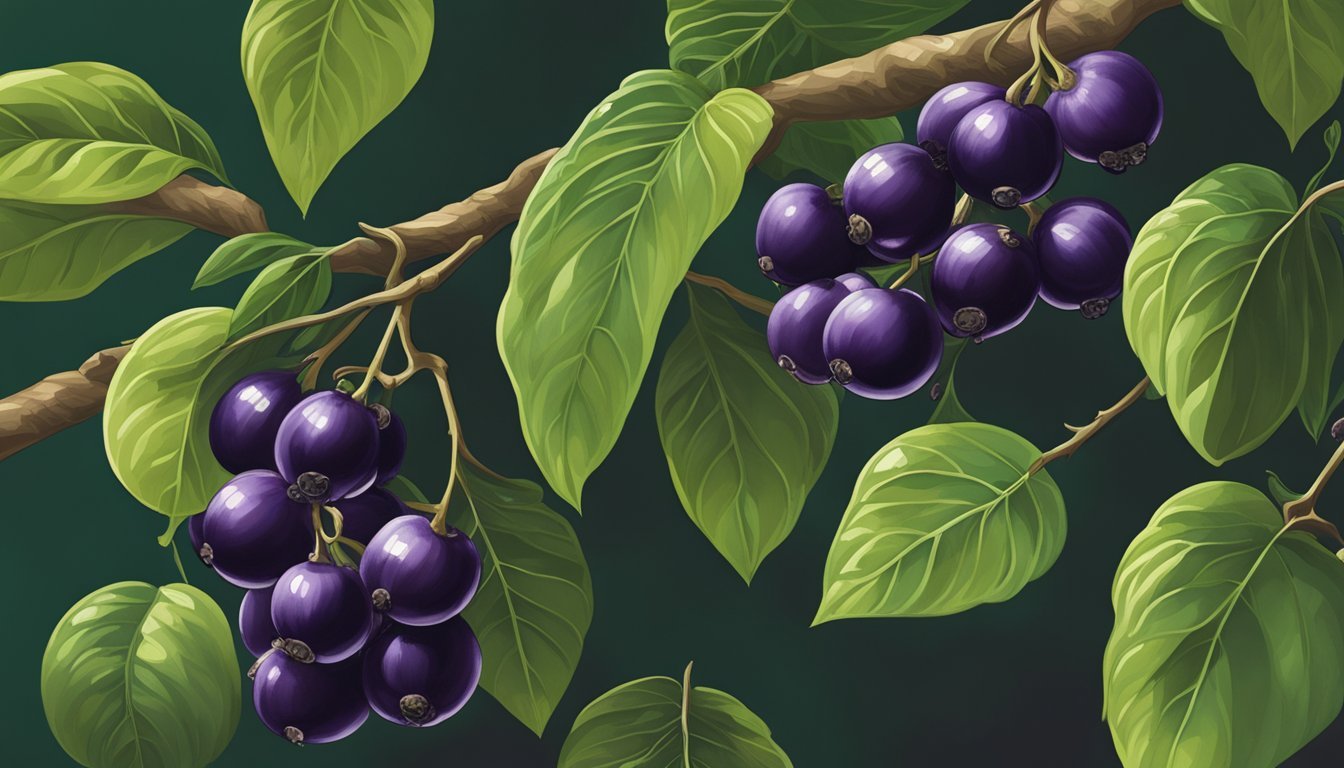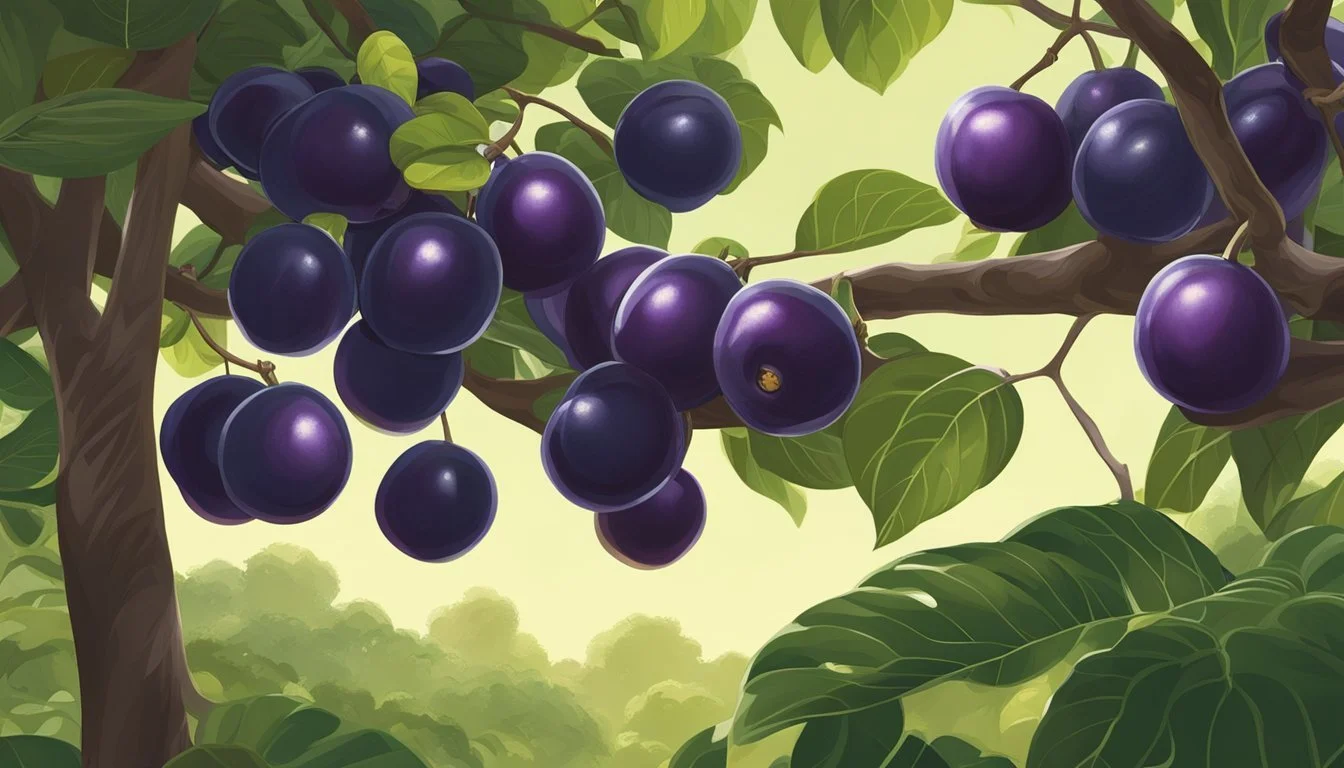How to Tell if a Jabuticaba is Ripe
Tips for Perfect Timing and Selection
Determining the ripeness of the Jabuticaba, a unique tropical fruit indigenous to Brazil and other regions of South America, is essential for enjoying its full flavor profile. Known for growing directly on the trunk of its tree, the Jabuticaba charms with its dark, grape-like appearance. Ripeness can be observed through a series of visual cues: immature Jabuticaba fruit is green, transitioning to a dark maroon-purple, and reaches near-black when ripe. This color change is often accompanied by a certain give under gentle pressure, similar to that of a ripe avocado or peach, indicating the fruit is ready to be enjoyed.
In the maturation process, the fruit will sometimes exhibit a marbled green and purple hue during its final stages, providing a visual indicator of its imminent readiness. Understanding this progression and the implications it holds for storage and consumption is just one piece of the puzzle. Proper care and optimal growing conditions are equally important in nurturing the fruit to its peak ripeness. The Jabuticaba thrives with regular watering, acidic soil conditions, and a balance of sun and shade, factors that contribute to not only the health of the tree but also the quality of the fruit it bears.
Key Takeaways
Ripeness of Jabuticaba is marked by a color shift from green to dark maroon-purple and softness to the touch.
Optimal care involves acidic soil, regular watering, and balanced sun exposure to ensure healthy growth and fruit development.
Successful cultivation and proper harvesting techniques result in a delicious, nutrient-rich tropical fruit, ready for consumption or use in various culinary and health contexts.
Identifying Jaboticaba
Proper identification of the ripe Jaboticaba fruit ensures you enjoy the texture and taste of these unique berries at their peak. The Jaboticaba, also known as Myrciaria cauliflora or Plinia cauliflora, bears a fruit with distinct physical characteristics when ripe, which carries important cultural significance in Brazil.
Physical Characteristics of Ripe Jaboticaba
The ripe Jaboticaba fruit can be identified by its deep purple to almost black skin. This thin skin covers a sweet, white flesh that is succulent and grape-like in texture. Unlike other berries, the Jaboticaba is distinct for its growth directly on the trunk and branches of the tree. During ripeness:
Size: The berries typically range from about 1.5 to 4 cm in diameter.
Color: A ripe Jaboticaba will exhibit a consistent deep purple hue.
Texture: The texture of a ripe fruit is plump with a bit of give when lightly squeezed.
Skin Integrity: The skin remains intact but is delicate and can be easily bruised, indicating ripeness.
Cultural Significance in Brazil
In Brazil, the Jaboticaba is more than just a fruit; it is a cultural icon. Often found in both backyard gardens and large commercial orchards, they are associated with family gatherings and tradition:
Harvest Celebrations: The fruit's harvest times are often cause for celebration due to its slow-growing nature and the fact that the tree can fruit up to five times a year.
Culinary Uses: Brazilian families use Jaboticaba to make jellies, wines, and liqueurs that embody the essence of Brazilian cuisine and hospitality.
Optimal Growing Conditions
Providing the right conditions for a Jaboticaba tree is crucial for its growth and fruit production. This section will detail how to create the ideal soil environment and maintain the necessary temperature and humidity levels for the tree.
Soil Requirements for a Jaboticaba Tree
Jaboticaba trees (Myrtaceae family) prefer acidic soil with a pH ranging from 4.0 to 6.5. It is essential that the soil is well-drained and rich in organic matter. To achieve this:
Use a mixture that includes compost to improve nutrient content and soil structure.
Ensure adequate drainage to prevent waterlogging, which can harm the roots.
For nutrient balance, soil should be supplemented with potassium, nitrogen, and phosphorus as necessary.
Temperature and Humidity Needs
Jaboticaba trees thrive in environments that offer full sun exposure and consistent warmth. Here's what to consider for the ideal climate:
The trees require a temperature range between 75°F and 95°F (24°C - 35°C) to fruit properly.
While they can tolerate a slight drop in temperature, they should be protected from freezing.
Jaboticaba trees benefit from high humidity levels, particularly during the flowering and fruiting stages.
By meeting these soil and climate conditions, Jaboticaba trees can be cultivated successfully to produce fruit. Regular monitoring and adjustments to the environment will help maintain these optimal growing conditions.
Caring for Your Jaboticaba Tree
Optimal care for your Jaboticaba tree can ensure a healthy and productive life span, potentially as a container plant, bonsai, or in-ground tree. Detailed attention to watering, fertilization, and pruning will help maintain tree vitality and fruit quality.
Watering and Fertilization
Watering: Jaboticaba trees require consistent moisture, especially during the establishment phase, but are sensitive to overwatering which can lead to root rot. Water newly planted trees twice weekly, making sure to soak the roots thoroughly. For established trees, a deep watering is beneficial when the top few inches of soil are dry.
In Containers: It's crucial to allow the soil to dry slightly between waterings to avoid waterlogging.
Fertilization: Apply complete fertilizer three times a year or use a specially formulated fruit tree fertilizer to ensure all nutrient requirements are met. High pH soils may necessitate additional fertilization.
Pest and Disease Management
Jaboticaba trees can be afflicted by pests like aphids and common diseases such as rust or root rot. Early detection and integrated pest management are key strategies to maintaining a healthy tree.
Pest Control: Regular inspection for pests and application of suitable organic or chemical controls can prevent infestations.
Disease Prevention: Proper watering techniques and adequate air circulation around the tree will help prevent fungal diseases. Remove and destroy infected leaves to control the spread of rust.
Pruning and Maintenance
Pruning is generally done to remove dead or diseased wood and to shape the tree, whether it is grown as a standard tree or as a bonsai. Maintenance efforts should focus on promoting good tree health and managing growth.
Pruning: Conduct light pruning periodically to maintain the desired shape and remove any unhealthy branches.
Health: Healthy root development is critical, especially in container-grown trees, with repotting necessary every few years to prevent root bound conditions. Regular monitoring for abnormalities in leaf color or texture can provide early warning signs of health issues.
Propagation Techniques
Propagating Jabuticaba effectively requires understanding the nuances of breeding this unique species. Various methods such as cultivating from seed, rooting cuttings, and grafting can yield successful results. It is essential for gardeners to choose a technique that suits their skill level and patience, as some methods take longer than others.
Cultivating from Seed
Seeds are the most natural but time-consuming way to propagate Jabuticaba plants. The germination process involves sowing the seeds in a well-draining soil mix and lightly covering them with soil. It is crucial to keep the soil moist and use a plastic cover to retain moisture until germination occurs. Gardeners should expect germination to take up to several weeks.
Rooting Cuttings
Propagating from cuttings is another method used by gardeners. They should select a healthy cutting from an established Jabuticaba plant and place it into a rooting hormone before planting. This should then be placed in a pot with a soil and perlite mix, ensuring the soil remains moist but not waterlogged to encourage root development.
Grafting for Varieties
Grafting is a sophisticated technique that allows gardeners to combine different varieties of Jabuticaba onto a single rootstock. The process entails joining a scion from a desired Jabuticaba cultivar onto an established plant's root system, ensuring that the vascular tissues align. This method is often used to propagate specific traits such as fruit size, taste, and resistance to disease.
Harvesting and Storage
The harvest and storage of Jaboticaba are crucial to maintaining the fruit’s taste and longevity. Understanding the signs of ripeness, employing the correct picking technique, and leveraging proper storage methods will ensure the highest quality fruit.
Determining the Perfect Harvest Time
Ripe Jaboticabas are identified by their deep purple to almost black coloration and a slight give to the touch. They typically reach this stage of ripeness shortly after the fruit turns color, which occurs once or twice a year depending on the climate. Monitoring the fruit’s color changes and gently squeezing are the most reliable indicators that picking time has arrived.
Proper Methods for Picking Jaboticaba
To harvest Jaboticabas, one should use a gentle twisting motion to avoid damaging the fruit and the tree. It is important that the picker does not pull directly, as this can harm the tree's branches and reduce future yields. Careful handling is paramount to preserving the fruit’s skin integrity, which is essential for maintaining freshness during storage.
Storing for Freshness
Once harvested, Jaboticabas should be stored in an airtight container to prolong their freshness. Storage in the refrigerator can significantly extend the fruit's life, typically allowing for enjoyment for up to three weeks. Maintaining the relatively high moisture content without condensation is essential to prevent prematurely shriveled or decayed fruit. For optimal storage:
Place ripe Jaboticabas in a breathable, airtight container.
Store the container in the refrigerator to delay overripening.
Check periodically for any signs of spoilage and consume within three weeks for best taste and texture.
Uses and Health Benefits
Jaboticaba, a fruit known for its unique growth directly on the trunk of the tree, is not only a culinary delight but also a powerhouse of nutrition and health benefits.
Nutritional Profile of Jaboticaba
The Jaboticaba fruit is dense with nutrients, boasting a variety of vitamins, minerals, and antioxidants. It is especially rich in vitamin C, iron, and contains a range of anthocyanins— a type of antioxidant. These antioxidants are crucial for reducing oxidative stress and fighting free radicals in the body. The fruit is also a good source of dietary fiber, which promotes digestive health.
Nutrient: Vitamin C
Benefit: Enhances immune function and skin health
Nutrient: Iron
Benefit: Vital for oxygen transport and energy production
Nutrient: Anthocyanins
Benefit: Antioxidant with anti-inflammatory properties
Nutrient: Fiber
Benefit: Aids in digestion and satiety
Culinary Applications
Jaboticaba fruit is versatile in the culinary world. It can be eaten fresh, or incorporated into various recipes. One popular usage is in the creation of jams and jellies, where its natural pectin aids in the gelling process. Additionally, due to its sweet and tart flavor profile, it is used to produce uniquely flavored wines and juices, which can range from simple homemade recipes to more sophisticated commercial productions.
Application: Fresh Eating
Description: Consumed raw when ripe for a burst of flavor
Application: Jam/Jelly
Description: Used for preserving the fruit; good with toast
Application: Wine
Description: Fermented to create a beverage with depth of flavor
Application: Juice
Description: Pressed to make a refreshing, healthful drink
In summary, Jaboticaba's nutritional profile and flexibility in culinary applications not only make it a popular choice for eating fresh but also for making delightful drinks, jams, and jellies that offer the dual benefits of flavor and health.






